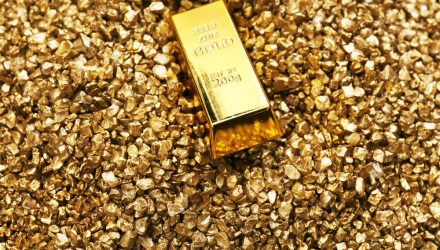As we consider the outlook for the gold market, exchange traded fund investors should take a look at the role of the asset class in a diversified portfolio, with a particular emphasis on gold royalty companies.
In the recent webcast, Could Gold Be Poised for a Comeback In 2023?, Frank Holmes, CEO and chief investment officer at U.S. Global Investors, highlighted the overarching theme of elevated and persistent inflationary pressures along with a weakening U.S. dollar, which could provide opportunities for gold investors.
Holmes also noted that gold has been a long-term performer, generating positive returns on an average annual basis of 80% over the past 20 years. The past year has been no different, as gold has been the best-performing asset after the U.S. dollar and Brent crude oil.
Holmes highlighted two significant trends that could support the gold outlook, including the “fear” trade and the “love” trade. For example, in the current environment, we are seeing gold’s traditional inverse relationship to interest rates, with rates beginning to dip and gold prices rebounding. Holmes also pointed to Shadowstats inflation data that revealed a significantly elevated inflationary environment, which may be even higher than what headline CPI tells us. This period of elevated inflation may be the type of environment that allows gold to shine its brightest, as the precious metal has historically outperformed during periods of high inflation and rising rates.
Meanwhile, on the so-called love side, investors are seeing increased demand from both domestic and international buyers, notably emerging market consumers in the quickly growing China and India markets. The growing middle class in emerging markets exhibits a penchant for gold demand both as a safety play and for jewelry. For instance, Indian women own six times more gold than Fort Knox. Meanwhile, central banks have been net buyers of gold with a significant spike in buying across recent months. China has even reported an increase in gold for the first time in over three years, and U.S. mint gold coin sales are at a 22-year high.
Gold has acted as a great store of wealth, especially as countries around the world debase their currencies. Total global debt has surpassed $300 trillion in 2021, with the Federal Reserve’s balance sheets ballooning in the post-COVID economic environment. On the other hand, gold prices have kept pace with aggressive money printing.
Along with direct gold exposure, investors can consider gold miners and sector-related ETFs like the U.S. Global GO GOLD and Precious Metal Miners ETF (NYSEArca: GOAU), a smart beta offering that tracks a specialized or rules-based index to help hone in on quality players in the gold mining space. The underlying U.S. Global GO GOLD and Precious Metal Miners Index uses quantitative analysis to pick stocks, with a particular focus on royalty companies.
U.S. Global believes royalty companies are a superior way to target the gold mining segment. Royalty companies are not responsible for costly infrastructure, so huge operating expenses can be avoided. These companies hold highly diversified portfolios of mines and other assets to mitigate concentration. Additionally, they generate some of the highest revenue per employee of all public companies while growing cash flows and dividends.
“A royalty company serves as a specialized financier that helps fund exploration and production projects for cash-strapped mining companies,” Holmes said.
GOAU includes a 30% tilt to royalty and streaming companies, which could help investors better manage common risks associated with traditional producers like building and maintaining mines. The lower risk may also further diminish risk since royalty companies have historically rewarded investors by increasing dividends at a faster pace than the broader equity market.
Financial advisors who are interested in learning more about the gold sector can watch the webcast here on demand.

